|
NATIONAL PARK SERVICE
Park Structures and Facilities |

|
DAMS and CROSSINGS
ALTHOUGH it is an inviolate principle, with respect to National Parks and Monuments, that artificial control of stream flow is to be rigidly avoided, the situation with respect to State Parks is somewhat different. While it is felt that in some cases such artificial control has been exerted to the detriment of valuable natural conditions without creating adequate compensatory values, there are undoubtedly situations, such as that in which a serious regional shortage of facilities for water recreation exists, which justify this sort of modification of natural conditions. Those who feel that primary emphasis should be placed on preservation of really natural scenery and on historic values earnestly urge a careful weighing of all prospective losses and gains before any decision is made to create an artificial body of water in a State Park. Granting then the occasional wisdom of such undertakings, simple naturalistic dams in which the objective in construction is the appearance of a natural waterfall are considered within the scope of this discussion.
The large dam is strictly an engineering problem and will not be considered in the present volume. Anything short of the most complete technical information—any skeletonized version possible within present space limitations—might prove more misinforming than otherwise. Furthermore, the dam that is other than miniature waterfall, has not so far proved very susceptible to coercive attempt to adapt its stubborn functionalism to a harmony with natural environment. As with telephone line and the incinerator, here is proper occasion for a philosophical counting of blessings, and for blindness to incorrectible artistic lack. The recreational and scenic benefits of a made lake must alone be counted on to justify the alien dam, without reliance on any feeble efforts to make the dam a parklike "feature." This, in a development of any considerable size, it can never be. It is true that large dams have been faced with stone to some softening of hard, rigid surfaces and lines. But always the failure of the undertaking to register anywhere near a perfect score has shown that the results have not justified the means.
Even the small dam usually has a structural core wall, of concrete or rubble, against and over which the "naturalism" is applied as a veneer. Too frequently the rock veneer follows too closely the regularity of the core wall, and betrays the fact that the dam is artificial. This can be avoided if the veneer strives for irregularity both in plan and in vertical section. The latter is accomplished by building out the lower courses in imitation of natural ledges. Variety in size of the rocks will add much to the natural appearance of the dam. Likewise should construction insure distribution of water, so that as much rock work as possible is screened by flow. To have all or any considerable portion of the dam exposed during low water may unmask an otherwise well-contrived naturalism.
If in our approach to park technique, the primitive has the right of way, the crossing as a picturesque survival has a place. For horse trails and even for secondary motor roads in parks where traffic is leisurely and not too heavy in volume, the ford is a legitimate and economical provision for crossing a shallow stream. This is subject to further reservations if tolerance of its quaintness is not to give way to annoyance on the part of the park user. The low water crossing will not meet with favor if the stream is normally subject to flood levels that make the crossing frequently impassable for automobiles. Equally conducive to public disapproval are a soft stream bed, treacherous holes or other hazards to safe negotiation. The approaches must not incline too sharply, nor may sight lines, as the ford is approached, be completely obscured by planting. Failure to provide these requisites to public acceptance of the ford is apt to provoke clamor of disapproval and lead to demands for its replacement with a bridge, to the eventual voiding of the economy it was sought to effect.
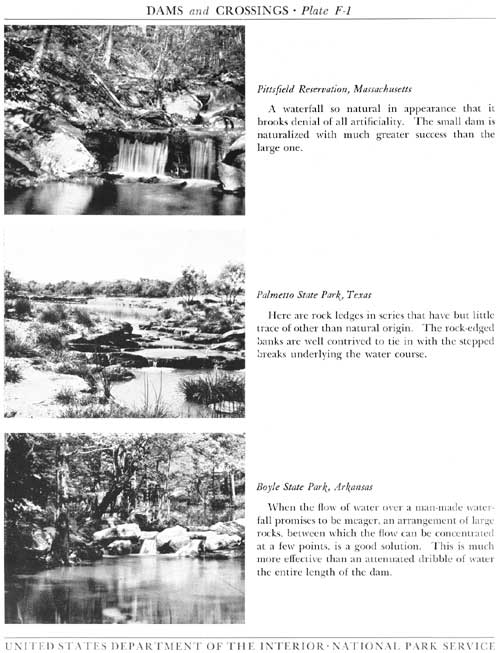
|
| Plate F-1 (click on image for a PDF version) |
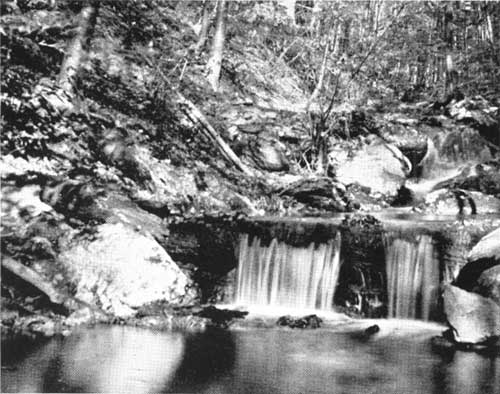
|
|
Pittsfield Reservation, Massachusetts A waterfall so natural in appearance that it brooks denial of all artificiality. The small dam is naturalized with much greater success than the large one. |
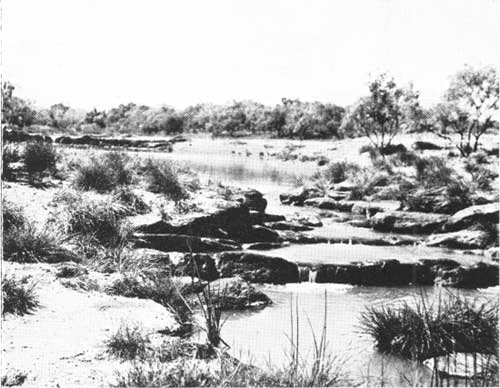
|
|
almetto State Park, Texas Here are rock ledges in series that have but little trace of other than natural origin. The rock-edged banks are well contrived to tie in with the stepped breaks underlying the water course. |
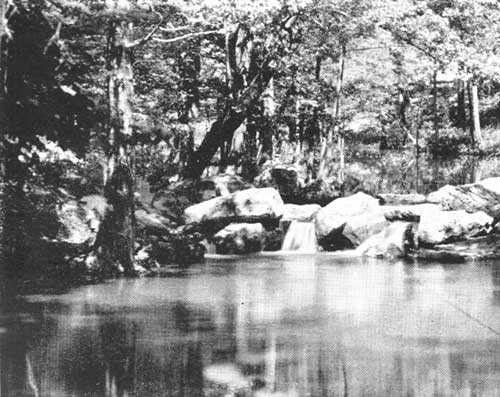
|
|
Boyle State Park, Arkansas When the flow of water over a man-made waterfall promises to be meager, an arrangement of large rocks, between which the flow can be concentrated at a few points, is a good solution. This is much more effective than an attenuated dribble of water the entire length of the dam. |
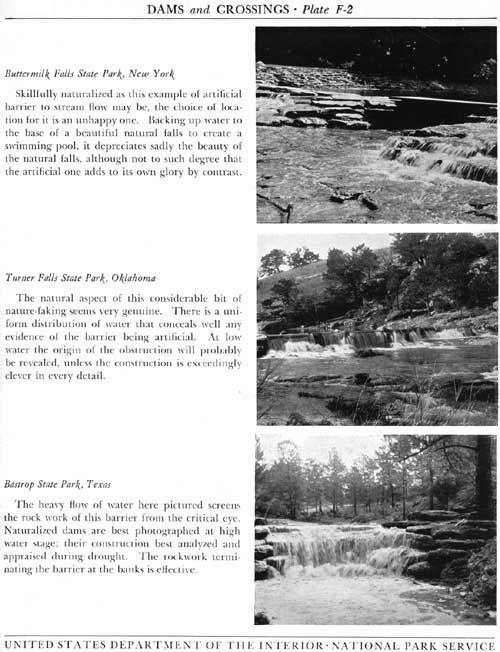
|
| Plate F-2 (click on image for a PDF version) |
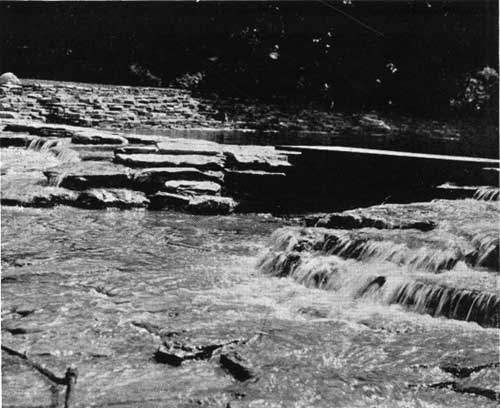
|
|
Buttermilk Falls State Park, New York Skillfully naturalized as this example of artificial barrier to stream flow may be, the choice of location for it is an unhappy one. Backing up water to the base of a beautiful natural falls to create a swimming pool, it depreciates sadly the beauty of the natural falls, although not to such degree that the artificial one adds to its own glory by contrast. |
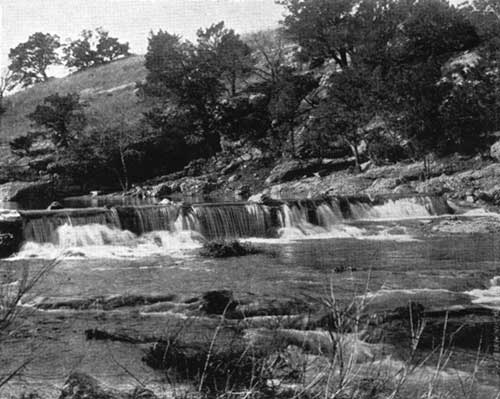
|
|
Turner Falls State Park, Oklahoma The natural aspect of this considerable bit of nature-faking seems very genuine. There is a uniform distribution of water that conceals well any evidence of the barrier being artificial. At low water the origin of the obstruction will probably be revealed, unless the construction is exceedingly clever in every detail. |
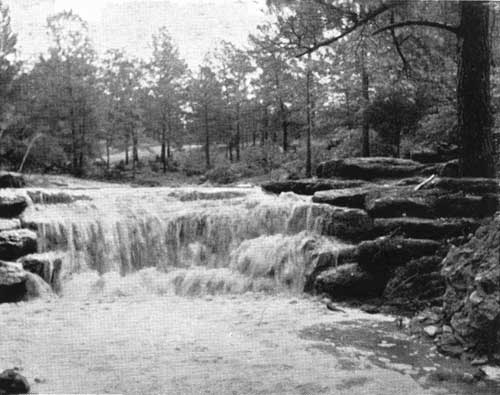
|
|
Bastrop State Park, Texas The heavy flow of water here pictured screens the rock work of this barrier from the critical eye. Naturalized dams are best photographed at high water stage; their construction best analyzed and appraised during drought. The rockwork terminating the barrier at the banks is effective. |
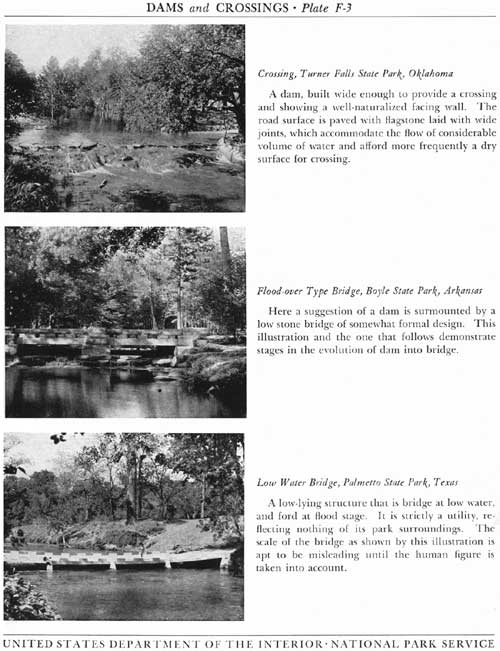
|
| Plate F-3 (click on image for a PDF version) |
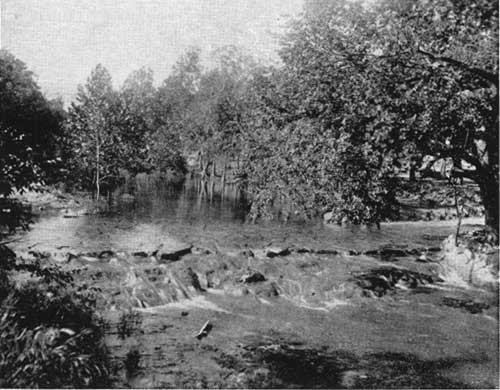
|
|
Crossing, Turner Falls State Park, Oklahoma A dam, built wide enough to provide a crossing and showing a well-naturalized facing wall. The road surface is paved with flagstone laid with wide joints, which accommodate the flow of considerable volume of water and afford more frequently a dry surface for crossing. |
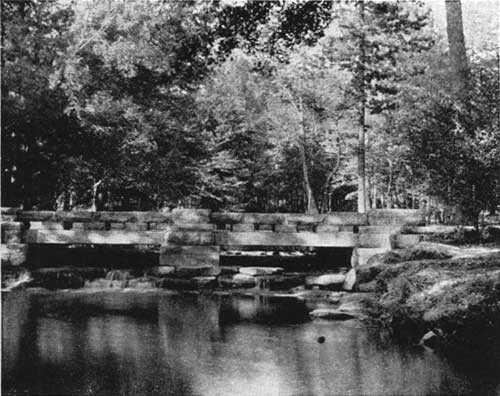
|
|
Flood-over Type Bridge, Boyle State Park, Arkansas Here a suggestion of a dam is surmounted by a low stone bridge of somewhat formal design. This illustration and the one that follows demonstrate stages in the evolution of dam into bridge. |
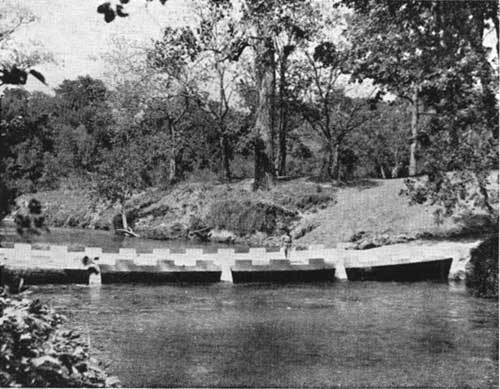
|
|
Low Water Bridge, Palmetto State Park, Texas A low-lying structure that is bridge at low water, and ford at flood stage. It is strictly a utility, reflecting nothing of its park surroundings. The scale of the bridge as shown by this illustration is apt to be misleading until the human figure is taken into account. |
| <<< Previous | <<< Contents>>> | Next >>> |
park_structures_facilities/secf.htm
Last Updated: 5-Dec-2011